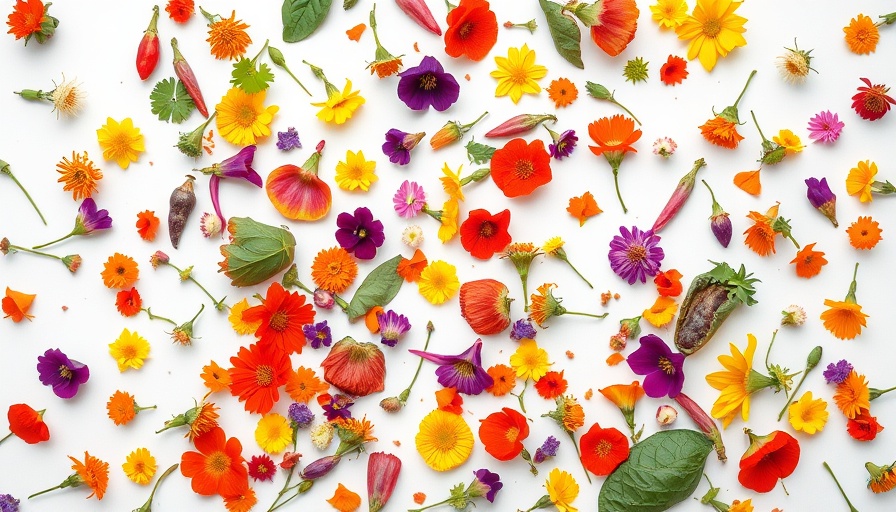
Discover the Hidden World of Edible Flowers
Flowers are not just for decoration; they can uplift your meals with unique flavors and vibrant colors. Edible flowers are a delightful yet often overlooked element in cooking and baking. While many are familiar with ornamental blooms, a wealth of edible varieties waits to tantalize your taste buds and enhance your culinary creations!
Why Edible Flowers Matter
Edible flowers are significant for both flavor and aesthetics. They not only beautify dishes but can also add interesting flavors—sweet, tart, or spicy. This allows home cooks and professional chefs alike to explore a universe of tastes beyond conventional ingredients.
Imagine plating a salad garnished with nasturtium flowers, which impart a peppery kick, or decorating a cake with delicate lavender blossoms that lend a hint of sweetness. By incorporating these blooms into everyday cooking, you can transform simple meals into extraordinary presentations.
The Top Ten Edible Flowers You Should Try
Ready to introduce edible flowers into your kitchen? Here is a curated list of ten must-try edible flowers:
- Nasturtiums: With a peppery flavor and vibrant colors, these flowers are perfect for salads.
- Roses: Known for their sweet fragrance and flavor, rose petals can elevate desserts.
- Calendula: Often called "pot marigold", its tangy taste is great in salads or as a garnish.
- Daylily: A versatile flower with a sweet and slightly earthy taste.
- Lavender: Used in desserts and savory dishes alike, lavender has a sweet and floral taste.
- Chive Blossoms: These add a mild onion flavor, making them an excellent choice in savory dishes.
- Echinacea: Not just for health benefits, its slightly spicy taste enhances a variety of dishes.
- Squash Blossoms: Popular in cooking, these flowers have a mild, sweet flavor.
- Dandelion: Its petals can be used in salads, while the rest of the plant can be brewed as tea.
- Viola (Pansy, Viola, & Violets): These flowers have a sweet, grassy flavor and are visually striking.
How to Grow Edible Flowers
If you're interested in cultivating your own edible flowers, the good news is that growing these beauties is not much different from raising herbs. Starting them from seed is common, and many can thrive in backyard gardens or even small pots on a balcony. Flowers like nasturtiums and chive can easily be started from seed while others may benefit from being purchased already grown.
To grow from seed, use a sterile seed-starting mix, and always label your sprouts for identification. Proper spacing is essential; avoid overcrowding by snipping out weaker seedlings. Finally, when it's time to harvest, pick your blooms during cooler parts of the day for optimal flavor!
Where to Find Edible Flowers
If the green thumb isn't your thing, fear not! You can source these blooms from various locations:
- Farmers' Markets: A great opportunity to purchase fresh flowers and engage with local growers.
- Local Greenhouses: Many carry seasonal edible flowers and can offer growing tips.
- Online Suppliers: Several reputable vendors specialize in edible flowers, ensuring quality and safety.
Culinary Tips for Using Edible Flowers
When looking to use edible flowers in your kitchen, consider that not all flowers are edible. Always ensure the flowers you use are pesticide-free and grown specifically for consumption. Rinse them gently and remove any bitter parts, such as the green sepals or stems.
For flavor enhancement, pair edible flowers with ingredients that complement their unique tastes. For example, combine roses with cream, nasturtiums with fish, or lavender with honey. The adventurous cook will find the possibilities passionate and thrilling!
The Emotional Impact of Edible Flowers
Flowers evoke emotions, and adding them to your meals can turn a simple gathering into a heartfelt occasion. Additionally, growing and cooking with edible flowers can foster a deeper connection with nature, enhancing well-being alongside culinary enjoyment.
Conclusion: Transform Your Cooking With Edible Flowers
You've just discovered the unique culinary world of edible flowers! Whether you're aiming to dazzle guests or just want to enhance your daily meals, these blooms can add vibrancy and flavor in delightful ways.
So, why not take the plunge? Spruce up your garden or visit your local farmers' market to try your luck at cooking with these floral delights. Embrace the beauty and flavor that edible flowers have to offer!
 Add Row
Add Row  Add
Add 




Write A Comment